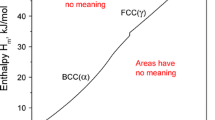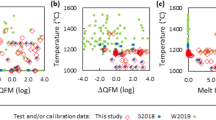Abstract
The results of a reconnaissance investigation of melting relationships in the system Fe-FeO at 16 GPa were recently described by Kato and Ringwood (1989). The principal sources of uncertainties in those experiments were caused by loss of FeO to sample capsules during runs and the estimation of sample temperatures by an indirect method, based upon a prior calibration of the relationship between power input and temperature. A further set of 24 runs at 16 GPa has been carried out using improved experimental techniques. The melting temperatures of iron and wüstite at 16 GPa are found to be 1945±20° C and 1875±25° C respectively. (Quoted errors do not include possible effects of pressure on thermocouple emf). The Fe-FeO eutectic is now located at 10±2 wt% FeO and 1670±20° C (previously 15.5±3 wt% FeO and 1700±25° C). The new determination of the depression of the melting point of iron by solution of FeO is 27.5° C/wt% FeO as compared to the previous value of 23° C/wt% FeO. The present results show that the contraction of the liquid immiscibility field in the system at high pressure is somewhat larger than was estimated previously. This study confirms the general topology of high pressure phase relationships in the Fe-FeO system obtained by Kato and Ringwood (1989) and has similar implications for the process of core formation within the Earth.
Similar content being viewed by others
References
Boehler R (1986) The phase diagram of iron to 430 kbar, Geophys Res Lett 13:1153–1156
Irifune T, Hibberson W (1985) Improved furnace design for multiple anvil apparatus for pressures up to 18 GPa and temperatures to 2000° C. High Temp High Pressures 17:575–579
Jeanloz R (1989) Physical chemistry at ultrahigh pressures and temperatures. Annu Rev Phys Chem 40:237–259
Jeanloz R (1990) The nature of the Earth's core. Annu Rev Earth Planet Sci 18 (in press)
Kato T, Ringwood AE (1989) Melting relationships in the system Fe-FeO at high pressures: implications for the composition and formation of the Earth's core. Phys Chem Minerals 16:524–538
Kato M, Urakawa S, Kumazawa M (1989) Stability fields of nonstoichiometric wüstite and magnesiowüstite at high pressure. Second Japan-USSR International Symposium on Phase Transformations at High Pressure and Temperatures, Program Abstract 80–81
Knittle E, Jeanloz R (1990) The high pressure phase diagram of Fe0.94O, a possible constituent of the Earth's outer core. J Geophys Res (in press)
Ringwood AE (1984) The Earth's core: its composition, formation and bearing upon the origin of the Earth. Proc Soc London A 395:1–46
Williams O, Jeanloz R, Bass J, Svendsen B, Ahrens T (1987) The melting curve of iron to 250 gigapascals: a constraint on the temperature at the Earth's Center, Science 236:181–182
Author information
Authors and Affiliations
Rights and permissions
About this article
Cite this article
Ringwood, A.E., Hibberson, W. The system Fe-FeO revisited. Phys Chem Minerals 17, 313–319 (1990). https://doi.org/10.1007/BF00200126
Received:
Issue Date:
DOI: https://doi.org/10.1007/BF00200126




